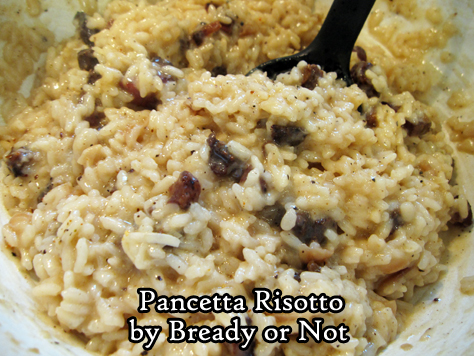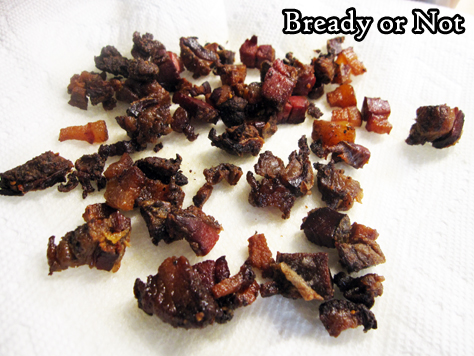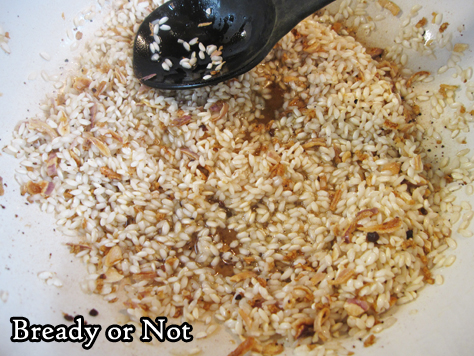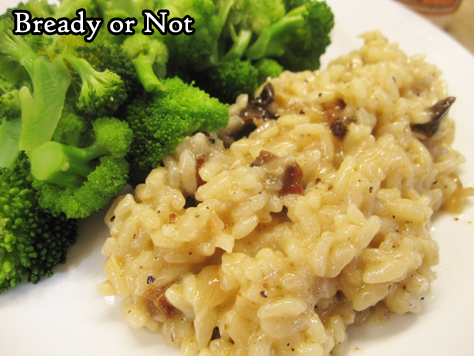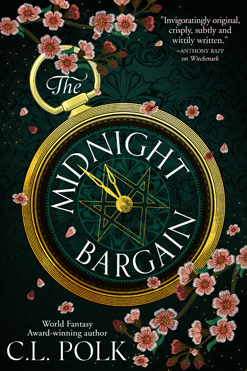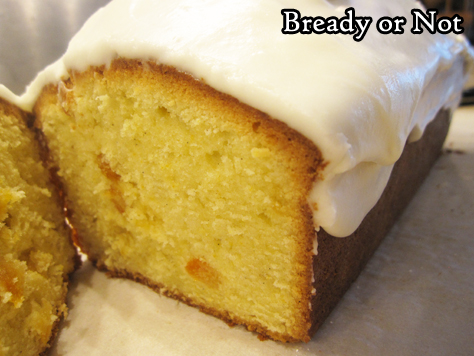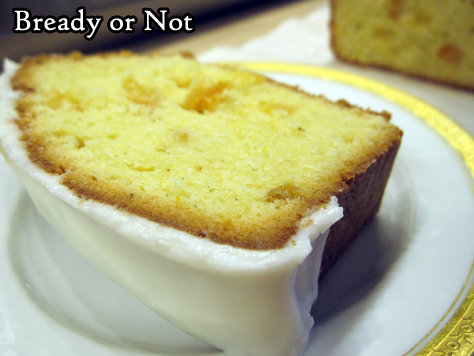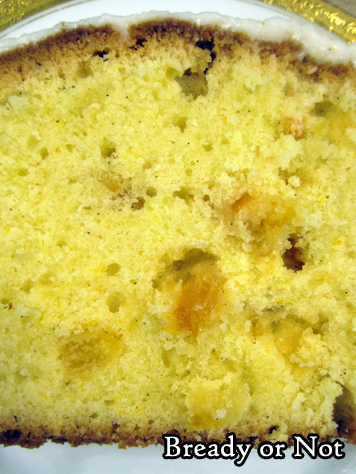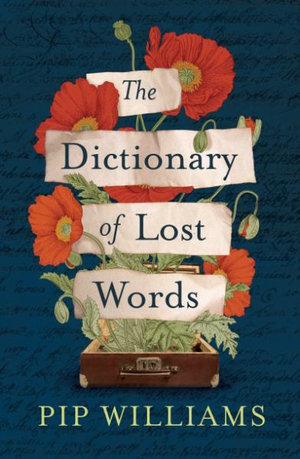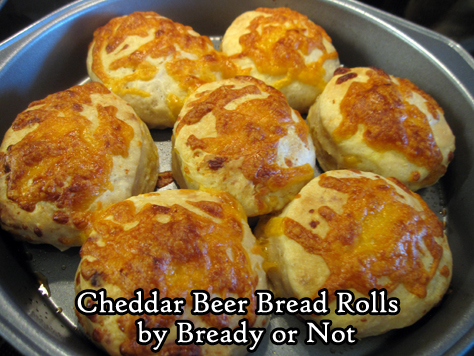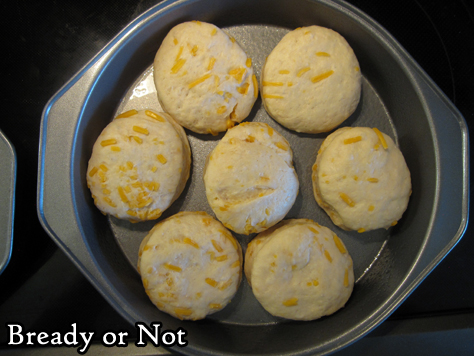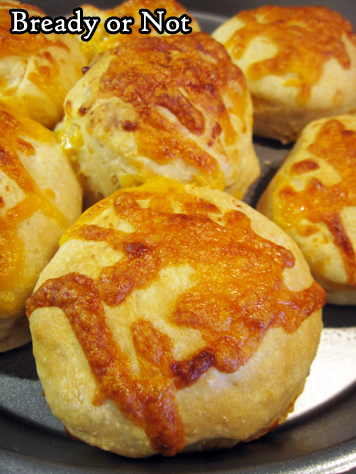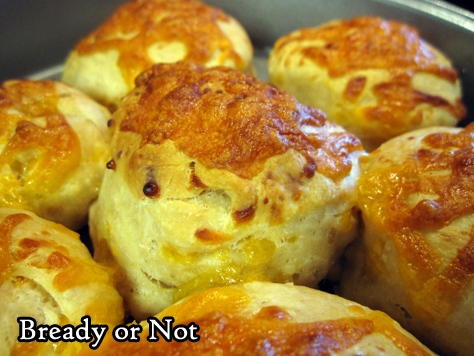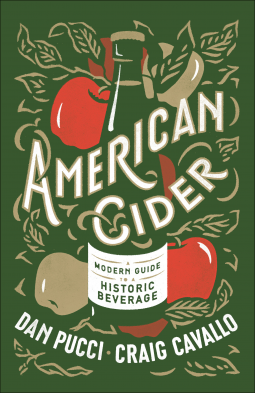Bready or Not Original: Pancetta Risotto
This Pancetta Risotto is a fantastic meal for two people, or a delicious side for a group. It’s time-consuming but very straightforward to make.
I confess, I spent years being intimidated by the very idea of a risotto. I would see it done on cooking shows. So much stirring! When I finally got up the gumption to give it a try, I found risotto wasn’t hard at all. It really is about lots of stirring.
This recipe here is my fancy occasion recipe, especially when I have some good pancetta on hand, such as the kind carried by Smoking Goose Meatery out of Indianapolis.
As for the wine, I’ve tried this with fancier Sauvignon Blanc from Total Wine (Cloudy Bay from New Zealand) as well as a $6 Trader Joe’s Coastal Sauvignon Blanc. Both versions turned out great! You don’t need to go all-out, but get something that is (hopefully) drinkable with the finished meal.
Bready or Not Original: Pancetta Risotto
Equipment
- large stock pot
- medium saucepan
Ingredients
- 8 oz pancetta diced
- 1 Tablespoon dried shallots or fresh shallot, finely minced
- 3 cloves garlic minced
- 1 1/4 cups Arborio rice
- 1 cup dry white wine Sauvignon Blanc works well
- 4 cups chicken broth or chicken stock, equal to a 32 oz box or 2 cans
- 1/2 cup shredded Parmesan or Pecorino Romano or Grana Padano, plus more to top rice
- salt and pepper to taste
Instructions
- In a large stock pot, cook the pancetta for 10 to 12 minutes, until it starts to turn brown and crispy. At the same time, on another stove burner, use a medium sauce pan to bring the chicken broth to a very low simmer.
- Use a slotted spoon to transfer pancetta to a paper towel-lined plate; set aside. Add dry shallots and garlic to the fat in the big pot. Sauté for two minutes. Add the Arborio rice and a pinch of salt. Sauté another 2 minutes, until the rice looks glossy with translucent edges.
- Add the white wine and stir until it is absorbed. Add chicken broth in 1/2 cup increments, stirring well after each addition until it is absorbed. After about 12 to 15 minutes, when most of the broth has been added, begin to taste the rice. The goal is a chewy, al dente consistency. Add more broth as needed, and remember to turn off the burner for the broth pot when it is empty.
- When the rice is creamy and al dente, stir in the pancetta and cheese. Taste the risotto again, adding more salt and pepper as needed. Serve with the remaining white wine.
OM NOM NOM!
Book Blog: The Midnight Bargain by C. L. Polk
I review everything I read and post reviews on Goodreads and LibraryThing. That’s not enough. Good books are meant to be shared. Therefore, I’m spotlighting some of my favorite reads here on my site.
The Midnight Bargain by C. L. Polk
out now in print and ebook; BookShop, B&N, and Amazon [affiliate link]
Beatrice Clayborn is a sorceress who practices magic in secret, terrified of the day she will be locked into a marital collar that will cut off her powers to protect her unborn children. She dreams of becoming a full-fledged Magus and pursuing magic as her calling as men do, but her family has staked everything to equip her for Bargaining Season, when young men and women of means descend upon the city to negotiate the best marriages. The Clayborns are in severe debt, and only she can save them, by securing an advantageous match before their creditors come calling.
In a stroke of luck, Beatrice finds a grimoire that contains the key to becoming a Magus, but before she can purchase it, a rival sorceress swindles the book right out of her hands. Beatrice summons a spirit to help her get it back, but her new ally exacts a price: Beatrice’s first kiss . . . with her adversary’s brother, the handsome, compassionate, and fabulously wealthy Ianthe Lavan.
The more Beatrice is entangled with the Lavan siblings, the harder her decision becomes: If she casts the spell to become a Magus, she will devastate her family and lose the only man to ever see her for who she is; but if she marries—even for love—she will sacrifice her magic, her identity, and her dreams. But how can she choose just one, knowing she will forever regret the path not taken?
I checked out this book from my library as part of my reading of Nebula finalists for this year.
I LOVE THIS BOOK. LOOOOOOOVE. It hits all of my sweet spots. A regency-inspired original world, with magic! Women striving for independence against societal expectations! A central romance with a guy who is a respectful, smart, supportive person, not a jerk! Smart heroines! Everything about this book is glorious and wonderful, including an ending that delivered a multitude of surprises and immense satisfaction.
Read MoreBready or Not: Glazed Citrus Loaf Cake
For times when you want some cake, not a huge cake, this Glazed Citrus Loaf Cake is about perfect.
It’s not some huge thing to store. It doesn’t take forever to make. It’s easy to slice up, individually wrap, and freeze portions for later.
Plus, it’s delicious. The cake is like a pound cake, soft and moist, with lemon and orange zest throughout. The bits of candied orange add a different texture in the mix.
Then there’s that luscious glaze. It’s not a heavy frosting, but a boost of sweetness to balance the zing of the citrus.
This is a great spring and summer kind of kind, one that tastes fresh and bright!
I modified this recipe from my favorite food magazine, Bake from Scratch, the March/April 2020 issue.
Bready or Not: Glazed Citrus Loaf Cake
Equipment
- 9x5 loaf pan
- parchment paper
Ingredients
Loaf
- 1 cup unsalted butter (2 sticks) softened
- 1 1/4 cups white sugar
- 2 medium lemons
- 1 medium orange
- 4 large eggs room temperature
- 2 teaspoons vanilla bean paste
- 2 cups cake flour
- 3/4 teaspoon kosher salt
- 1/4 teaspoon baking powder
- 1/3 cup milk room temperature
- 1 teaspoon cake flour
- 1/2 cup candied orange slices finely chopped
Vanilla Glaze
- 1 1/2 cup confectioners' sugar plus more if needed
- 2 Tablespoons half & half or heavy cream
- 2 Tablespoons unsalted butter melted
- 1 teaspoon vanilla extract
- 1/4 teaspoon kosher salt
Instructions
- Wash, dry, and zest both lemons and orange. Set aside the fruit for another use.
- Preheat oven at 325-degrees. Cut a piece of parchment paper to fit into a loaf pan and extend up the long sides, like a sling. Apply nonstick spray in pan, then press in parchment and add more spray. Set aside.
- In a big bowl, beat butter, sugar, and zests together until they are fluffy, scraping the sides of the bowl often. Add eggs one by one, followed by the vanilla paste. The batter may look a bit curdled.
- In a separate medium bowl, combine the flour, salt, and baking powder. Gradually add it into the butter mix along with the milk. Batter will now be thick.
- In a small bowl, toss together the candied orange bits and the teaspoon of cake flour to coat. Fold it into the batter.
- Pour everything into the prepared loaf pan and even out the top.
- Bake for 40 minutes. Rotate pan in oven. Bake for another 40 minutes. Test the middle with a toothpick for doneness, and bake for another 5 to 20 minutes, until the toothpick comes out clean.
- Let loaf cool in pan for 10 minutes, then use the parchment to lift it onto a rack to cool completely.
- Make the vanilla glaze by mixing together all the ingredients until they are smooth and at a thick, pourable consistency. Immediately drizzle and smear over the top of the cake, letting excess artfully drip over the sides. Let glaze set for 30 minutes, then slice in.
- Wrap cake and keep at room temperature. It can also be cut into individual slices and frozen for later enjoyment.
OM NOM NOM!
Book Blog: The Dictionary of Lost Words by Pip Williams
I review everything I read and post reviews on Goodreads and LibraryThing. That’s not enough. Good books are meant to be shared. Therefore, I’m spotlighting some of my favorite reads here on my site.
The Dictionary of Lost Words by Pip Williams
out now in print and ebook; BookShop, B&N, and Amazon [affiliate link]
I received a copy of this book from the publisher via NetGalley.
Brilliantly written, thoroughly researched, deeply emotional. The Dictionary of Lost Words is an incredible work of literary and historical fiction.
The lead character, Esme, grows up with the Oxford English Dictionary. Motherless, curious, she spends many of her earliest days playing and observing beneath the desk of her father in the ‘Scriptorium,’ set up in a shed on the Oxford grounds. It’s there she finds the abandoned slip for ‘bondmaid’ and begins collecting more words. At first, she steals discards from the Scriptorium, but as she grows up, she realizes there are lost words everywhere–words deemed too crude or low class to be included the decades-long labor of the dictionary, words especially used by women and the dismissed of society. She collects her words along with life experiences.
This is a profound book, truly. It’s about words, and people, and love, and loss. It’s never preachy, but the messages are there. The way everything is delicately laced together is a marvel. The end of the book made me weepy more than once. There are some terrible tragic turns, and then–the very ending is a surprise culmination that resolves everything with stunning sweetness.
Read MoreBready or Not: Cheddar Beer Bread Rolls
These Cheddar Beer Bread Rolls taste as good as they look. Seriously.
When the pandemic sent everything topsy-turvy in spring 2020, my husband ended up working from home more often. That meant I needed to feed him more often.
So, like so many people, I started baking more bread. These rolls were among the first of my experiments, and they were a major hit.
The original recipe from New York Times Cooking made a huge batch of rolls. I needed enough rolls to feed one guy, with a extras frozen for later.
I rewrote the recipe to delicious results. I used a Guilt Lifter beer to make these, which lent a refreshing hoppy flavor. A heavier and darker beer will create heavier and darker flavor. Try different beers to suit your tastes and match your meal.
Bready or Not: Cheddar Beer Bread Rolls
Equipment
- 2 8-or 9-inch cake pans
- 2.5-inch round cutter
- plastic wrap
- basting brush
Ingredients
- 2 Tablespoons unsalted butter divided
- 3 cups all-purpose flour or bread flour
- 1/2 Tablespoons instant yeast
- 1 teaspoon coarse kosher salt
- 2 Tablespoons honey
- 1 cup beer room temperature
- 1 cup shredded cheese 120 grams
Instructions
- Divide the two tablespoons of butter in half, separating them to soften at room temperature.
- In a stand mixer with a bread hook attachment, stir together the flour, yeast, and salt. Follow up with 1 tablespoon of softened butter, honey, and beer. Mix on low speed for 4 minutes, scraping the bowl as needed. Increase the speed to medium for another 2 minutes, pulling the dough from the hook a few times. Add about half the cheese, reserving the rest to go on top later. Mix the cheese until it's distributed through the dough.
- Lightly grease a large bowl. Transfer the dough there and cover with plastic wrap or a towel to let it rise until it's about doubled in size, about an hour.
- Grease the two cake pans. Prepare a lightly floured surface and tip the dough onto it. Pat the dough out into a thick, even layer. Use the cutter to slice out rolls. Place them not quite touching in the pans. Reform scraps as much as possible to shape into more rolls. The rolls likely won't quite fill both pans.
- Cover pans with plastic wrap and set in a warm place to rise again for 35 to 45 minutes. They may not increase a lot in size, but they should look puffy.
- Preheat oven at 400-degrees.
- Pull out remaining pat of butter and cheese. Brush the soft butter over the rolls, and follow up with a sprinkling of cheese. Try to keep the cheese from touching the edge of the pan, where it could burn.
- Place both pans in the oven and bake until the rolls are browned and cheese is melted, 15 to 20 minutes. A digital thermometer in a center roll should read 190-degrees at minimum.
- Let cool for at least 10 minutes before (carefully) pulling apart and serving.
- Rolls can keep in a sealed bag at room temperature for up to 2 days. They can also be frozen and thawed for later enjoyment. They taste best hot. For best results, wrap them in foil and bake at 400 for about 10 minutes to warm them through.
OM NOM NOM!
Book Blog: American Cider: A Modern Guide to a Historic Beverage by Dan Pucci & Craig Cavallo
I review everything I read and post reviews on Goodreads and LibraryThing. That’s not enough. Good books are meant to be shared. Therefore, I’m spotlighting some of my favorite reads here on my site.
American Cider: A Modern Guide to a Historic Beverage by Dan Pucci & Craig Cavallo
out now in print and ebook; BookShop, B&N, and Amazon [affiliate link]
I received an advance copy of this book via NetGalley.
American Cider sets about–and succeeds–with two major goals. First of all, it essentially lays out American history, region by region, by following the progression of apple trees, and by extension, the brewing of cider. It doesn’t ignore the fact that this is also a story of colonialism. White settlers brought their seeds and scions, and the planting of apple trees was among the first things done when establishing households in what was once Native American land. Likewise, when tribes were forced from their homelands and onto reservations, the destruction of their buildings and apple trees was included in that effort. Props to the authors for being up-front about that aspect of apples–that honesty ads a lot to the book, and prevents it from feeling like a lengthy propaganda piece on the awesomeness of apples…
…Though let us not deny, apples are indeed awesome. The authors’ passion and knowledge of their subject matter also comes through, loud and clear. This isn’t a book for the person vaguely-interested in apples and cider, though it is an engaging read all the way through. This is a book for the foodies, for the people who really love cider and wants to understand it more, and those who are interested in starting their own cidery.
On that note, the book’s second major emphasis in in describing and exploring up-and-coming cideries across the country. Wow, did these sections make me want to go on a road trip and try everything that was out there. The information is pretty detailed. They lay out the geography and climate and how that impacts apples, what has been grown in the past, what grows now, and various other details about varying business operations. It definitely inspired me to buy cider at Trader Joe’s this week when I recognized a name from this book.
I highly recommend this book for anyone who enjoys American cider and wants to understand the history, present, and future trajectory of the beverage. (As for me, I hope that trajectory means it is pouring straight down my gullet.)
Read More



